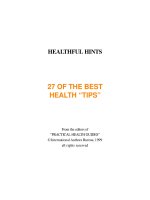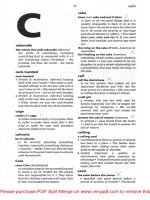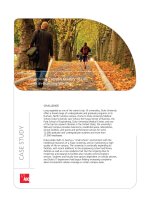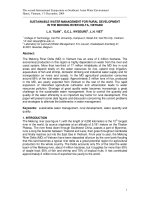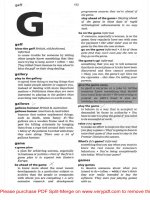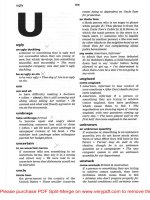Tài liệu Hypertension - Clinical management of primary hypertension in adults pdf
Bạn đang xem bản rút gọn của tài liệu. Xem và tải ngay bản đầy đủ của tài liệu tại đây (274.62 KB, 36 trang )
Issue date: August 2011
NICE clinical guideline 127
Developed by the Newcastle Guideline Development and Research Unit and
updated by the National Clinical Guideline Centre (formerly the National
Collaborating Centre for Chronic Conditions) and the British Hypertension Society
Hypertension
Clinical management of primary
hypertension in adults
This guideline partially updates and
replaces NICE clinical guideline 34
NICE clinical guideline 127
Hypertension: clinical management of primary hypertension in adults
Ordering information
You can download the following documents from
www.nice.org.uk/guidance/CG127
• The NICE guideline (this document) – all the recommendations.
• A quick reference guide – a summary of the recommendations for
healthcare professionals.
• ‘Understanding NICE guidance’ – a summary for patients and carers.
• The full guideline – all the recommendations, details of how they were
developed, and reviews of the evidence they were based on.
For printed copies of the quick reference guide or ‘Understanding NICE
guidance’, phone NICE publications on 0845 003 7783 or email
and quote:
N2636 (quick reference guide)
N2637 (‘Understanding NICE guidance’).
NICE clinical guidelines are recommendations about the treatment and care of
people with specific diseases and conditions in the NHS in England and
Wales.
This guidance represents the view of NICE, which was arrived at after careful
consideration of the evidence available. Healthcare professionals are
expected to take it fully into account when exercising their clinical judgement.
However, the guidance does not override the individual responsibility of
healthcare professionals to make decisions appropriate to the circumstances
of the individual patient, in consultation with the patient and/or guardian or
carer, and informed by the summary of product characteristics of any drugs
they are considering.
Implementation of this guidance is the responsibility of local commissioners
and/or providers. Commissioners and providers are reminded that it is their
responsibility to implement the guidance, in their local context, in light of their
duties to avoid unlawful discrimination and to have regard to promoting
equality of opportunity. Nothing in this guidance should be interpreted in a way
that would be inconsistent with compliance with those duties.
National Institute for Health and Clinical Excellence
MidCity Place
71 High Holborn
London WC1V 6NA
www.nice.org.uk
© National Institute for Health and Clinical Excellence, 2011. All rights reserved. This material
may be freely reproduced for educational and not-for-profit purposes. No reproduction by or
for commercial organisations, or for commercial purposes, is allowed without the express
written permission of NICE.
Contents
Introduction 5
Person-centred care 6
Key priorities for implementation 7
1 Guidance 10
1.1 Measuring blood pressure 10
1.2 Diagnosing hypertension 11
1.3 Assessing cardiovascular risk and target organ damage 14
1.4 Lifestyle interventions 15
1.5 Initiating and monitoring antihypertensive drug treatment, including
blood pressure targets 16
1.6 Choosing antihypertensive drug treatment 17
1.7 Patient education and adherence to treatment 20
2 Notes on the scope of the guidance 21
3 Implementation 22
4 Research recommendations 23
4.1 Out-of-office monitoring 23
4.2 Intervention thresholds for people aged under 40 with hypertension 23
4.3 Methods of assessing lifetime CV risk in people aged under 40 years
with hypertension 24
4.4 Optimal systolic blood pressure 24
4.5 Step 4 antihypertensive treatment 25
4.6 Automated blood pressure monitoring in people with atrial fibrillation 25
5 Other versions of this guideline 25
6 Related NICE guidance 26
7 Updating the guideline 27
Appendix A: The Guideline Development Groups, National Collaborating
Centres and NICE project team 28
Appendix B: The Guideline Review Panels 33
Appendix C: The algorithms 35
NHS Evidence has accredited the process used by the Centre for Clinical Practice at
NICE to produce guidelines. Accreditation is valid for 3 years from April 2010 and is
applicable to guidance produced using the processes described in NICE’s ‘The
guidelines manual’ (2009). More information on accreditation can be viewed at
www.evidence.nhs.uk
NICE clinical guideline 127 – Hypertension 4
This guidance updates and replaces NICE clinical guideline 34 (published in
2006). NICE clinical guideline 34 updated and replaced NICE clinical
guideline 18 (published in 2004).
The original 2004 guideline was developed by the Newcastle Guideline
Development and Research Unit. The guideline was updated by the National
Clinical Guideline Centre (NCGC) (formerly the National Collaborating Centre
for Chronic Conditions [NCC-CC]) in collaboration with the British
Hypertension Society (BHS) in 2006 and 2011.
Recommendations are marked as [2004], [2004, amended 2011], [2006],
[2008], [2009], [2010] or [new 2011].
[2004] indicates that the evidence has not been updated and reviewed
since 2004
[2004, amended 2011] indicates that the evidence has not been updated
and reviewed since 2004 but a small amendment has been made to the
recommendation
[2006] indicates that the evidence has not been updated and reviewed
since 2006
[2008] applies to recommendations from ‘Lipid modification’ (NICE clinical
guideline 67), published in 2008
[2009] applies to recommendations from ‘Medicines adherence’ (NICE
clinical guideline 76), published in 2009
[2010] applies to recommendations from ‘Hypertension in pregnancy’
(NICE clinical guideline 107), published in 2010
[new 2011] indicates that the evidence has been reviewed and the
recommendation has been updated or added.
NICE clinical guideline 127 – Hypertension 5
Introduction
High blood pressure (hypertension) is one of the most important preventable
causes of premature morbidity and mortality in the UK. Hypertension is a
major risk factor for ischaemic and haemorrhagic stroke, myocardial infarction,
heart failure, chronic kidney disease, cognitive decline and premature death.
Untreated hypertension is usually associated with a progressive rise in blood
pressure. The vascular and renal damage that this may cause can culminate
in a treatment-resistant state.
Blood pressure is normally distributed in the population and there is no natural
cut-off point above which 'hypertension' definitively exists and below which it
does not. The risk associated with increasing blood pressure is continuous,
with each 2 mmHg rise in systolic blood pressure associated with a 7%
increased risk of mortality from ischaemic heart disease and a 10% increased
risk of mortality from stroke. Hypertension is remarkably common in the UK
and the prevalence is strongly influenced by age. In any individual person,
systolic and/or diastolic blood pressures may be elevated. Diastolic pressure
is more commonly elevated in people younger than 50. With ageing, systolic
hypertension becomes a more significant problem, as a result of progressive
stiffening and loss of compliance of larger arteries. At least one quarter of
adults (and more than half of those older than 60) have high blood pressure.
The clinical management of hypertension is one of the most common
interventions in primary care, accounting for approximately £1 billion in drug
costs alone in 2006.
The guideline will assume that prescribers will use a drug’s summary of
product characteristics to inform decisions made with individual patients.
This guideline recommends drugs for indications for which they do not have a
UK marketing authorisation at the date of publication, if there is good evidence
to support that use. Where recommendations have been made for the use of
drugs outside their licensed indications (‘off-label use’), these drugs are
marked with a footnote in the recommendations.
NICE clinical guideline 127 – Hypertension 6
Person-centred care
This guideline offers best practice advice on the care of adults with
hypertension.
Treatment and care should take into account people’s needs and preferences.
People with hypertension should have the opportunity to make informed
decisions about their care and treatment, in partnership with their healthcare
professionals. If people do not have the capacity to make decisions,
healthcare professionals should follow the Department of Health’s advice on
consent (available from www.dh.gov.uk/en/DH_103643) and the code of
practice that accompanies the Mental Capacity Act (summary available from
www.dh.gov.uk/en/SocialCare/Deliveringsocialcare/MentalCapacity). In
Wales, healthcare professionals should follow advice on consent from the
Welsh Government (available from www.wales.nhs.uk/consent).
Good communication between healthcare professionals and people with
hypertension is essential. It should be supported by evidence-based written
information tailored to the person’s needs. Treatment and care, and the
information people are given about it, should be culturally appropriate. It
should also be accessible to people with additional needs such as physical,
sensory or learning disabilities, and to people who do not speak or read
English.
If the person agrees, families and carers should have the opportunity to be
involved in decisions about treatment and care.
Families and carers should also be given the information and support
they need.
NICE clinical guideline 127 – Hypertension 7
Key priorities for implementation
The following recommendations have been identified as priorities for
implementation.
Diagnosing hypertension
If the clinic blood pressure is 140/90 mmHg or higher, offer ambulatory
blood pressure monitoring (ABPM) to confirm the diagnosis of
hypertension. [new 2011]
When using ABPM to confirm a diagnosis of hypertension, ensure that at
least two measurements per hour are taken during the person’s usual
waking hours (for example, between 08:00 and 22:00).
Use the average value of at least 14 measurements taken during the
person’s usual waking hours to confirm a diagnosis of hypertension.
[new 2011]
When using home blood pressure monitoring (HBPM) to confirm a
diagnosis of hypertension, ensure that:
for each blood pressure recording, two consecutive measurements are
taken, at least 1 minute apart and with the person seated and
blood pressure is recorded twice daily, ideally in the morning and
evening and
blood pressure recording continues for at least 4 days, ideally for 7 days.
Discard the measurements taken on the first day and use the average
value of all the remaining measurements to confirm a diagnosis of
hypertension. [new 2011]
NICE clinical guideline 127 – Hypertension 8
Initiating and monitoring antihypertensive drug treatment, including
blood pressure targets
Initiating treatment
Offer antihypertensive drug treatment to people aged under 80 years with
stage 1 hypertension who have one or more of the following:
target organ damage
established cardiovascular disease
renal disease
diabetes
a 10-year cardiovascular risk equivalent to 20% or greater. [new 2011]
Offer antihypertensive drug treatment to people of any age with stage 2
hypertension. [new 2011]
For people aged under 40 years with stage 1 hypertension and no
evidence of target organ damage, cardiovascular disease, renal disease or
diabetes, consider seeking specialist evaluation of secondary causes of
hypertension and a more detailed assessment of potential target organ
damage. This is because 10-year cardiovascular risk assessments can
underestimate the lifetime risk of cardiovascular events in these people.
[new 2011]
Monitoring treatment and blood pressure targets
For people identified as having a ‘white-coat effect’
1
, consider ABPM or
HBPM as an adjunct to clinic blood pressure measurements to monitor the
response to antihypertensive treatment with lifestyle modification or drugs.
[new 2011]
Choosing antihypertensive drug treatment
Offer people aged 80 years and over the same antihypertensive drug
treatment as people aged 55–80 years, taking into account any
comorbidities. [new 2011]
1
A discrepancy of more than 20/10 mmHg between clinic and average daytime ABPM or
average HBPM blood pressure measurements at the time of diagnosis.
NICE clinical guideline 127 – Hypertension 9
Step 1 treatment
Offer step 1 antihypertensive treatment with a calcium-channel blocker
(CCB) to people aged over 55 years and to black people of African or
Caribbean family origin of any age. If a CCB is not suitable, for example
because of oedema or intolerance, or if there is evidence of heart failure or
a high risk of heart failure, offer a thiazide-like diuretic. [new 2011]
If diuretic treatment is to be initiated or changed, offer a thiazide-like
diuretic, such as chlortalidone (12.5–25.0 mg once daily) or indapamide
(1.5 mg modified-release or 2.5 mg once daily) in preference to a
conventional thiazide diuretic such as bendroflumethiazide or
hydrochlorothiazide. [new 2011]
For people who are already having treatment with bendroflumethiazide or
hydrochlorothiazide and whose blood pressure is stable and well
controlled, continue treatment with the bendroflumethiazide or
hydrochlorothiazide. [new 2011]
Step 4 treatment
For treatment of resistant hypertension at step 4:
Consider further diuretic therapy with low-dose spironolactone (25 mg
once daily)
2
if the blood potassium level is 4.5 mmol/l or lower. Use
particular caution in people with a reduced estimated glomerular filtration
rate because they have an increased risk of hyperkalaemia.
Consider higher-dose thiazide-like diuretic treatment if the blood
potassium level is higher than 4.5 mmol/l. [new 2011]
2
At the time of publication (August 2011), spironolactone did not have UK marketing
authorisation for this indication. Informed consent should be obtained and documented.
NICE clinical guideline 127 – Hypertension 10
1 Guidance
The following guidance is based on the best available evidence. The full
guideline (www.nice.org.uk/guidance/CG127) gives details of the methods
and the evidence used to develop the guidance.
Definitions
In this guideline the following definitions are used.
Stage 1 hypertension Clinic blood pressure is 140/90 mmHg or higher
and subsequent ambulatory blood pressure monitoring (ABPM) daytime
average or home blood pressure monitoring (HBPM) average blood
pressure is 135/85 mmHg or higher.
Stage 2 hypertension Clinic blood pressure is 160/100 mmHg or higher
and subsequent ABPM daytime average or HBPM average blood pressure
is 150/95 mmHg or higher.
Severe hypertension Clinic systolic blood pressure is 180 mmHg or higher
or clinic diastolic blood pressure is 110 mmHg or higher.
1.1 Measuring blood pressure
1.1.1 Healthcare professionals taking blood pressure measurements
need adequate initial training and periodic review of their
performance. [2004]
1.1.2 Because automated devices may not measure blood pressure
accurately if there is pulse irregularity (for example, due to atrial
fibrillation), palpate the radial or brachial pulse before measuring
blood pressure. If pulse irregularity is present, measure blood
pressure manually using direct auscultation over the brachial
artery. [new 2011]
1.1.3 Healthcare providers must ensure that devices for measuring blood
pressure are properly validated, maintained and regularly
recalibrated according to manufacturers’ instructions. [2004]
NICE clinical guideline 127 – Hypertension 11
1.1.4 When measuring blood pressure in the clinic or in the home,
standardise the environment and provide a relaxed, temperate
setting, with the person quiet and seated, and their arm
outstretched and supported. [new 2011]
1.1.5 If using an automated blood pressure monitoring device, ensure
that the device is validated
3
and an appropriate cuff size for the
person’s arm is used. [new 2011]
1.1.6 In people with symptoms of postural hypotension (falls or postural
dizziness):
measure blood pressure with the person either supine or seated
measure blood pressure again with the person standing for at
least 1 minute prior to measurement. [2004, amended 2011]
1.1.7 If the systolic blood pressure falls by 20 mmHg or more when the
person is standing:
review medication
measure subsequent blood pressures with the person standing
consider referral to specialist care if symptoms of postural
hypotension persist. [2004, amended 2011]
1.2 Diagnosing hypertension
1.2.1 When considering a diagnosis of hypertension, measure blood
pressure in both arms.
If the difference in readings between arms is more than
20 mmHg, repeat the measurements.
If the difference in readings between arms remains more than
20 mmHg on the second measurement, measure subsequent
blood pressures in the arm with the higher reading. [new 2011]
3
A list of validated blood pressure monitoring devices is available on the British Hypertension
Society’s website (see www.bhsoc.org). The British Hypertension Society is an independent
reviewer of published work. This does not imply any endorsement by NICE.
NICE clinical guideline 127 – Hypertension 12
1.2.2 If blood pressure measured in the clinic is 140/90 mmHg or higher:
Take a second measurement during the consultation.
If the second measurement is substantially different from the
first, take a third measurement.
Record the lower of the last two measurements as the clinic blood
pressure. [new 2011]
1.2.3 If the clinic blood pressure is 140/90 mmHg or higher, offer
ambulatory blood pressure monitoring (ABPM) to confirm the
diagnosis of hypertension. [new 2011]
1.2.4 If a person is unable to tolerate ABPM, home blood pressure
monitoring (HBPM) is a suitable alternative to confirm the diagnosis
of hypertension. [new 2011]
1.2.5 If the person has severe hypertension, consider starting
antihypertensive drug treatment immediately, without waiting for the
results of ABPM or HBPM. [new 2011]
1.2.6 While waiting for confirmation of a diagnosis of hypertension, carry
out investigations for target organ damage (such as left ventricular
hypertrophy, chronic kidney disease and hypertensive retinopathy)
(see recommendation 1.3.3) and a formal assessment of
cardiovascular risk using a cardiovascular risk assessment tool
(see recommendation 1.3.2). [new 2011]
1.2.7 If hypertension is not diagnosed but there is evidence of target
organ damage such as left ventricular hypertrophy, albuminuria or
proteinuria, consider carrying out investigations for alternative
causes of the target organ damage. [new 2011]
1.2.8 If hypertension is not diagnosed, measure the person’s clinic blood
pressure at least every 5 years subsequently, and consider
measuring it more frequently if the person’s clinic blood pressure is
close to 140/90 mmHg. [new 2011]
NICE clinical guideline 127 – Hypertension 13
1.2.9 When using ABPM to confirm a diagnosis of hypertension, ensure
that at least two measurements per hour are taken during the
person’s usual waking hours (for example, between 08:00 and
22:00).Use the average value of at least 14 measurements taken
during the person’s usual waking hours to confirm a diagnosis of
hypertension. [new 2011]
1.2.10 When using HBPM to confirm a diagnosis of hypertension, ensure
that:
for each blood pressure recording, two consecutive
measurements are taken, at least 1 minute apart and with the
person seated and
blood pressure is recorded twice daily, ideally in the morning and
evening and
blood pressure recording continues for at least 4 days, ideally for
7 days.
Discard the measurements taken on the first day and use the
average value of all the remaining measurements to confirm a
diagnosis of hypertension. [new 2011]
1.2.11 Refer the person to specialist care the same day if they have:
accelerated hypertension, that is, blood pressure usually higher
than 180/110 mmHg with signs of papilloedema and/or retinal
haemorrhage or
suspected phaeochromocytoma (labile or postural hypotension,
headache, palpitations, pallor and diaphoresis). [2004,
amended 2011]
1.2.12 Consider the need for specialist investigations in people with signs
and symptoms suggesting a secondary cause of hypertension.
[2004, amended 2011]
NICE clinical guideline 127 – Hypertension 14
1.3 Assessing cardiovascular risk and target organ
damage
For NICE guidance on the early identification and management of
chronic kidney disease see 'Chronic kidney disease' (NICE clinical
guideline 73, 2008).
1.3.1 Use a formal estimation of cardiovascular risk to discuss prognosis
and healthcare options with people with hypertension, both for
raised blood pressure and other modifiable risk factors. [2004]
1.3.2 Estimate cardiovascular risk in line with the recommendations on
Identification and assessment of CVD risk in ‘Lipid modification’
(NICE clinical guideline 67)
4
. [2008]
1.3.3 For all people with hypertension offer to:
test for the presence of protein in the urine by sending a urine
sample for estimation of the albumin:creatinine ratio and test for
haematuria using a reagent strip
take a blood sample to measure plasma glucose, electrolytes,
creatinine, estimated glomerular filtration rate, serum total
cholesterol and HDL cholesterol
examine the fundi for the presence of hypertensive retinopathy
arrange for a 12-lead electrocardiograph to be performed.
[2004, amended 2011]
4
Clinic blood pressure measurements must be used in the calculation of cardiovascular risk.
NICE clinical guideline 127 – Hypertension 15
1.4 Lifestyle interventions
For NICE guidance on the prevention of obesity and cardiovascular
disease see 'Obesity' (NICE clinical guideline 43, 2006) and 'Prevention of
cardiovascular disease at population level' (NICE public health
guidance 25, 2010).
1.4.1 Lifestyle advice should be offered initially and then periodically to
people undergoing assessment or treatment for hypertension.
[2004]
1.4.2 Ascertain people’s diet and exercise patterns because a healthy
diet and regular exercise can reduce blood pressure. Offer
appropriate guidance and written or audiovisual materials to
promote lifestyle changes. [2004]
1.4.3 Relaxation therapies can reduce blood pressure and people may
wish to pursue these as part of their treatment. However, routine
provision by primary care teams is not currently recommended.
[2004]
1.4.4 Ascertain people’s alcohol consumption and encourage a reduced
intake if they drink excessively, because this can reduce blood
pressure and has broader health benefits. [2004]
1.4.5 Discourage excessive consumption of coffee and other caffeine-
rich products. [2004]
1.4.6 Encourage people to keep their dietary sodium intake low,
either by reducing or substituting sodium salt, as this can reduce
blood pressure. [2004]
1.4.7 Do not offer calcium, magnesium or potassium supplements as a
method for reducing blood pressure. [2004]
1.4.8 Offer advice and help to smokers to stop smoking. [2004]
NICE clinical guideline 127 – Hypertension 16
1.4.9 A common aspect of studies for motivating lifestyle change is the
use of group working. Inform people about local initiatives by, for
example, healthcare teams or patient organisations that provide
support and promote healthy lifestyle change. [2004]
1.5 Initiating and monitoring antihypertensive drug
treatment, including blood pressure targets
Initiating treatment
1.5.1 Offer antihypertensive drug treatment to people aged under
80 years with stage 1 hypertension who have one or more of
the following:
target organ damage
established cardiovascular disease
renal disease
diabetes
a 10-year cardiovascular risk equivalent to 20% or greater.
[new 2011]
1.5.2 Offer antihypertensive drug treatment to people of any age with
stage 2 hypertension. [new 2011]
1.5.3 For people aged under 40 years with stage 1 hypertension and no
evidence of target organ damage, cardiovascular disease, renal
disease or diabetes, consider seeking specialist evaluation of
secondary causes of hypertension and a more detailed assessment
of potential target organ damage. This is because 10-year
cardiovascular risk assessments can underestimate the lifetime risk
of cardiovascular events in these people. [new 2011]
Monitoring treatment and blood pressure targets
1.5.4 Use clinic blood pressure measurements to monitor the response
to antihypertensive treatment with lifestyle modifications or drugs.
[new 2011]
NICE clinical guideline 127 – Hypertension 17
1.5.5 Aim for a target clinic blood pressure below 140/90 mmHg in
people aged under 80 years with treated hypertension. [new 2011]
1.5.6 Aim for a target clinic blood pressure below 150/90 mmHg in
people aged 80 years and over, with treated hypertension. [new
2011]
1.5.7 For people identified as having a ‘white-coat effect’
5
, consider
ABPM or HBPM as an adjunct to clinic blood pressure
measurements to monitor the response to antihypertensive
treatment with lifestyle modification or drugs. [new 2011]
1.5.8 When using ABPM or HBPM to monitor the response to treatment
(for example, in people identified as having a ‘white-coat effect’
5
and people who choose to monitor their blood pressure at home),
aim for a target average blood pressure during the person’s usual
waking hours of:
below 135/85 mmHg for people aged under 80 years
below 145/85 mmHg for people aged 80 years and over.
[new 2011]
1.6 Choosing antihypertensive drug treatment
1.6.1 Where possible, recommend treatment with drugs taken only once
a day. [2004]
1.6.2 Prescribe non-proprietary drugs where these are appropriate and
minimise cost. [2004]
1.6.3 Offer people with isolated systolic hypertension (systolic blood
pressure 160 mmHg or more) the same treatment as people with
both raised systolic and diastolic blood pressure. [2004]
5
A discrepancy of more than 20/10 mmHg between clinic and average daytime ABPM or
average HBPM blood pressure measurements at the time of diagnosis.
NICE clinical guideline 127 – Hypertension 18
1.6.4 Offer people aged 80 years and over the same antihypertensive
drug treatment as people aged 55–80 years, taking into account
any comorbidities. [new 2011]
1.6.5 Offer antihypertensive drug treatment to women of child-bearing
potential in line with the recommendations on Management of
pregnancy with chronic hypertension and Breastfeeding in
‘Hypertension in pregnancy’ (NICE clinical guideline 107). [2010]
Step 1 treatment
1.6.6 Offer people aged under 55 years step 1 antihypertensive
treatment with an angiotensin-converting enzyme (ACE) inhibitor or
a low-cost angiotensin-II receptor blocker (ARB). If an ACE inhibitor
is prescribed and is not tolerated (for example, because of cough),
offer a low-cost ARB. [new 2011]
1.6.7 Do not combine an ACE inhibitor with an ARB to treat
hypertension. [new 2011]
1.6.8 Offer step 1 antihypertensive treatment with a calcium-channel
blocker (CCB) to people aged over 55 years and to black people of
African or Caribbean family origin of any age. If a CCB is not
suitable, for example because of oedema or intolerance, or if there
is evidence of heart failure or a high risk of heart failure, offer a
thiazide-like diuretic. [new 2011]
1.6.9 If diuretic treatment is to be initiated or changed, offer a
thiazide-like diuretic, such as chlortalidone (12.5–25.0 mg once
daily) or indapamide (1.5 mg modified-release once daily or 2.5 mg
once daily) in preference to a conventional thiazide diuretic such as
bendroflumethiazide or hydrochlorothiazide. [new 2011]
1.6.10 For people who are already having treatment with
bendroflumethiazide or hydrochlorothiazide and whose blood
pressure is stable and well controlled, continue treatment with the
bendroflumethiazide or hydrochlorothiazide. [new 2011]
NICE clinical guideline 127 – Hypertension 19
1.6.11 Beta-blockers are not a preferred initial therapy for hypertension.
However, beta-blockers may be considered in younger people,
particularly:
those with an intolerance or contraindication to ACE inhibitors
and angiotensin II receptor antagonists or
women of child-bearing potential or
people with evidence of increased sympathetic drive. [2006]
1.6.12 If therapy is initiated with a beta-blocker and a second drug is
required, add a calcium-channel blocker rather than a thiazide-like
diuretic to reduce the person’s risk of developing diabetes. [2006]
Step 2 treatment
1.6.13 If blood pressure is not controlled by step 1 treatment, offer step 2
treatment with a CCB in combination with either an ACE inhibitor or
an ARB
6
. [new 2011]
1.6.14 If a CCB is not suitable for step 2 treatment, for example because
of oedema or intolerance, or if there is evidence of heart failure or a
high risk of heart failure, offer a thiazide-like diuretic. [new 2011]
1.6.15 For black people of African or Caribbean family origin, consider an
ARB
6
in preference to an ACE inhibitor, in combination with a CCB.
[new 2011]
Step 3 treatment
1.6.16 Before considering step 3 treatment, review medication to ensure
step 2 treatment is at optimal or best tolerated doses. [new 2011]
1.6.17 If treatment with three drugs is required, the combination of ACE
inhibitor or angiotensin II receptor blocker, calcium-channel blocker
and thiazide-like diuretic should be used. [2006]
6
Choose a low-cost ARB.
NICE clinical guideline 127 – Hypertension 20
Step 4 treatment
1.6.18 Regard clinic blood pressure that remains higher than
140/90 mmHg after treatment with the optimal or best tolerated
doses of an ACE inhibitor or an ARB plus a CCB plus a diuretic as
resistant hypertension, and consider adding a fourth
antihypertensive drug and/or seeking expert advice. [new 2011]
1.6.19 For treatment of resistant hypertension at step 4:
Consider further diuretic therapy with low-dose spironolactone
(25 mg once daily)
7
if the blood potassium level is 4.5 mmol/l or
lower. Use particular caution in people with a reduced estimated
glomerular filtration rate because they have an increased risk of
hyperkalaemia.
Consider higher-dose thiazide-like diuretic treatment if the blood
potassium level is higher than 4.5 mmol/l. [new 2011]
1.6.20 When using further diuretic therapy for resistant hypertension at
step 4, monitor blood sodium and potassium and renal function
within 1 month and repeat as required thereafter. [new 2011]
1.6.21 If further diuretic therapy for resistant hypertension at step 4 is not
tolerated, or is contraindicated or ineffective, consider an alpha- or
beta-blocker. [new 2011]
1.6.22 If blood pressure remains uncontrolled with the optimal or
maximum tolerated doses of four drugs, seek expert advice if it has
not yet been obtained. [new 2011]
1.7 Patient education and adherence to treatment
1.7.1 Provide appropriate guidance and materials about the benefits of
drugs and the unwanted side effects sometimes experienced in
order to help people make informed choices. [2004]
7
At the time of publication (August 2011), spironolactone did not have UK marketing
authorisation for this indication. Informed consent should be obtained and documented.
NICE clinical guideline 127 – Hypertension 21
1.7.2 People vary in their attitudes to their hypertension and their
experience of treatment. It may be helpful to provide details of
patient organisations that provide useful forums to share views and
information. [2004]
1.7.3 Provide an annual review of care to monitor blood pressure,
provide people with support and discuss their lifestyle, symptoms
and medication. [2004]
1.7.4 Because evidence supporting interventions to increase adherence
is inconclusive, only use interventions to overcome practical
problems associated with non-adherence if a specific need is
identified. Target the intervention to the need. Interventions might
include:
suggesting that patients record their medicine-taking
encouraging patients to monitor their condition
simplifying the dosing regimen
using alternative packaging for the medicine
using a multi-compartment medicines system.
(This recommendation is taken from ‘Medicines adherence’ [NICE
clinical guideline 76].) [2009]
2 Notes on the scope of the guidance
NICE guidelines are developed in accordance with a scope that defines what
the guideline will and will not cover. The scope of this guideline is available
from www.nice.org.uk/CG127.
Groups that will be covered
Adults with hypertension (18 years and older). Particular consideration will
be given to the needs of black people of African and Caribbean family
origin and minority ethnic groups where these differ from the needs of the
general population.
People aged 80 years or older.
NICE clinical guideline 127 – Hypertension 22
Groups that will not be covered
People with diabetes.
Children and young people (younger than 18 years).
Pregnant women.
Secondary causes of hypertension (for example, Conn's adenoma,
phaeochromocytoma and renovascular hypertension).
People with accelerated hypertension (that is, severe acute hypertension
associated grade III retinopathy and encephalopathy).
People with acute hypertension or high blood pressure in emergency care
settings.
How this guideline was developed
NICE commissioned the National Clinical Guideline Centre to update this
guideline. The Centre established a Guideline Development Group (see
appendix A), which reviewed the evidence and updated the
recommendations. An independent Guideline Review Panel oversaw the
updating of the guideline (see appendix B).
There is more information about how NICE clinical guidelines are developed
on the NICE website (www.nice.org.uk/HowWeWork). A booklet, ‘How NICE
clinical guidelines are developed: an overview for stakeholders, the public
and the NHS’ (fourth edition, published 2009), is available from NICE
publications (phone 0845 003 7783 or email and
quote reference N1739).
3 Implementation
NICE has developed tools to help organisations implement this guidance (see
www.nice.org.uk/guidance/CG127).
NICE clinical guideline 127 – Hypertension 23
4 Research recommendations
The Guideline Development Group has made the following recommendations
for research, based on its review of evidence, to improve NICE guidance and
patient care in the future.
4.1 Out-of-office monitoring
In adults with primary hypertension, does the use of out-of-office monitoring
(HBPM or ABPM) improve response to treatment?
Why this is important
There is likely to be increasing use of HBPM and for the diagnosis of
hypertension as a consequence of this guideline update. There are, however,
very few data regarding the utility of HBPM or ABPM as means of monitoring
blood pressure control or as indicators of clinical outcome in treated
hypertension, compared with clinic blood pressure monitoring. Studies should
incorporate HBPM and/or ABPM to monitor blood pressure responses to
treatment and their usefulness as indicators of clinical outcomes.
4.2 Intervention thresholds for people aged under 40 with
hypertension
In people aged under 40 years with hypertension, what are the appropriate
thresholds for intervention?
Why this is important
There is uncertainty about how to assess the impact of blood pressure
treatment in people aged under 40 years with stage 1 hypertension and no
overt target organ damage or cardiovascular disease (CVD). In particular, it is
not known whether those with untreated hypertension are more likely to
develop target organ damage and, if so, whether such damage is reversible.
Target organ damage and CVD as surrogate or intermediate disease markers
are the only indicators that are likely to be feasible in younger people because
traditional clinical outcomes are unlikely to occur in sufficient numbers over
the timescale of a typical clinical trial. The data will be important to inform
NICE clinical guideline 127 – Hypertension 24
treatment decisions for younger people with stage 1 hypertension who do not
have overt target organ damage.
4.3 Methods of assessing lifetime cardiovascular risk in
people aged under 40 years with hypertension
In people aged under 40 years with hypertension, what is the most accurate
method of assessing the lifetime risk of cardiovascular events and the impact
of therapeutic intervention on this risk?
Why this is important
Current short-term (10-year) risk estimates are likely to substantially
underestimate the lifetime cardiovascular risk of younger people (aged under
40 years) with hypertension, because short-term risk assessment is powerfully
influenced by age. Nevertheless, the lifetime risk associated with untreated
stage 1 hypertension in this age group could be substantial. Lifetime risk
assessments may be a better way to inform treatment decisions and evaluate
the cost effectiveness of earlier intervention with pharmacological therapy.
4.4 Optimal systolic blood pressure
In people with treated hypertension, what is the optimal systolic blood
pressure?
Why this is important
Data on optimal blood pressure treatment targets, particularly for systolic
blood pressure, are inadequate. Current guidance is largely based on the
blood pressure targets adopted in clinical trials but there have been no large
trials that have randomised people with hypertension to different systolic blood
pressure targets and that have had sufficient power to examine clinical
outcomes.
NICE clinical guideline 127 – Hypertension 25
4.5 Step 4 antihypertensive treatment
In adults with hypertension, which drug treatment (diuretic therapy versus
other step 4 treatments) is the most clinically and cost effective for step 4
antihypertensive treatment?
Why this is important
Although this guideline provides recommendations on the use of further
diuretic therapy for treatment at step 4 (resistant hypertension), they are
largely based on post-hoc observational data from clinical trials. More data are
needed to compare further diuretic therapies, for example a potassium-
sparing diuretic with a higher-dose thiazide-like diuretic, and to compare
diuretic therapy with alternative treatment options at step 4 to define whether
further diuretic therapy is the best option.
4.6 Automated blood pressure monitoring in people with
atrial fibrillation
Which automated blood pressure monitors are suitable for people with
hypertension and atrial fibrillation?
Why this is important
Atrial fibrillation may prevent accurate blood pressure measurement with
automated devices. It would be valuable to know if this can be overcome.
5 Other versions of this guideline
5.1 Full guideline
The full guideline, ‘Hypertension: the clinical management of primary
hypertension in adults’ contains details of the methods and evidence used to
develop the guideline. It is published by the National Clinical Guideline Centre,
and is available from our website
(www.nice.org.uk/guidance/CG127/Guidance).



